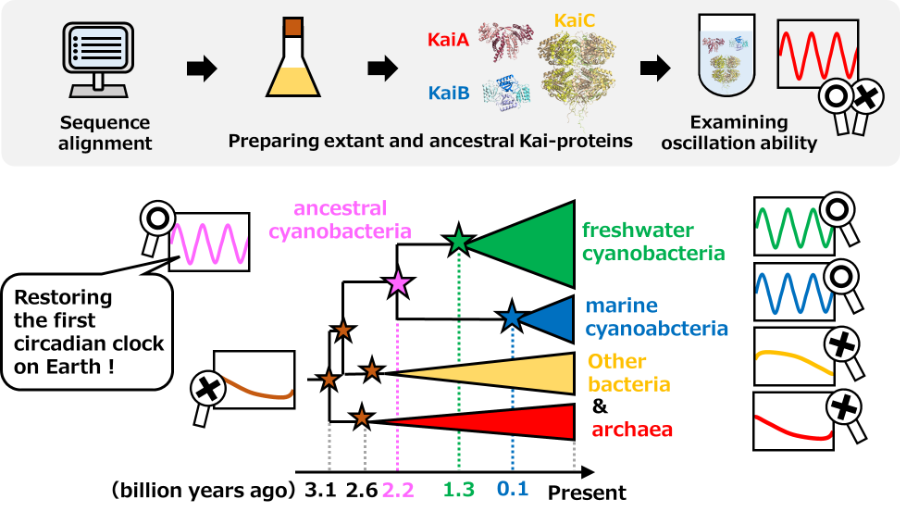Reviewed by Lexie CornerMay 21 2025
A Japanese research team has studied ancient timekeeping systems to better understand the circadian clock in modern cyanobacteria. The researchers compared the functions of ancestral Kai proteins with the oscillatory behavior of the KaiA, KaiB, and KaiC proteins that regulate the circadian rhythm in present-day cyanobacteria.
 Molecular evolution of Kai-protein oscillator over 3 billion years. Image Credit: Yoshihiko Furuike & Atsushi Mukaiyama
Molecular evolution of Kai-protein oscillator over 3 billion years. Image Credit: Yoshihiko Furuike & Atsushi Mukaiyama
Their findings were published in the journal Nature Communications.
Extant cyanobacteria utilize a circadian clock to predict the light-dark environmental cycle by Earth's rotation to achieve efficient photosynthetic reactions. We wanted to know the evolutionary history of when ancient bacteria acquired the circadian clock and how this property was inherited by the present cyanobacteria.
Atsushi Mukaiyama, Associate Professor, Fukui Prefectural University
Cyanobacteria, also known as blue-green algae, are photosynthetic bacteria that have significantly impacted Earth’s atmosphere and oceans. According to scientists, the most recent common ancestor of cyanobacteria appeared about 3 billion years ago.
The Great Oxidation Event, which occurred roughly 2.3 billion years ago when the amount of oxygen in Earth’s atmosphere increased, played a key role in the evolution of today’s ecosystems.
This evolutionary process continued through the Neoproterozoic Oxygenation Event, when oxygen levels rose for a second time, and through at least two Snowball Earth events, during which the planet was covered in ice approximately 2.4 and 0.7 billion years ago.
The Neoproterozoic Oxygenation Event occurred between 800 million and 540 million years ago.
Through fossil studies and molecular evolution models, researchers suggest that the most recent common ancestor of cyanobacteria already possessed primitive oxygenic photosynthetic systems. The efficiency of photosynthesis is significantly influenced by light-dark environmental cycles.
The research team aimed to investigate whether primitive cyanobacteria had a timekeeping system when photosynthesis became active during the Great Oxidation Event, potentially offering insight into the physiological origins of circadian clock systems.
Circadian clocks, internal timekeepers that regulate an organism’s 24-hour cycle, have been identified in various organisms, including bacteria, fungi, plants, and mammals. The researchers focused on the circadian clock of the cyanobacterial strain Synechococcus elongatus.
They reconstructed the clock oscillator in vitro using the clock protein KaiC and analyzed the function and structure of ancestral Kai proteins to understand the evolutionary development of self-sustained Kai-protein oscillators.
Recognizing that light-dark cycles affect photosynthetic efficiency in cyanobacteria, the team sought to determine whether ancient cyanobacteria had a self-sustained circadian clock during the early oxidation events when photosynthetic systems were first established.
They found that ancestral clock proteins encoded a faster rhythmic phenomenon.
The ancient cyanobacterial clock was synchronized to the cycle of 18 to 20 hours. This means that the history of the Earth's rotation period has been restored by tracing the evolution of clock protein molecules.
Yoshihiko Furuike, Assistant Professor, Institute for Molecular Science, Fukui Prefectural University
According to the team's findings, the earliest KaiC in ancestral bacteria lacked the structure and function necessary for rhythmic activity.
Through molecular evolution, the ancestral Kai proteins acquired the structure and function needed to respond to the Great Oxidation and Snowball Earth events. Eventually, this self-sustaining circadian oscillator was inherited by the most recent common ancestor of photosynthesis-capable cyanobacteria.
These findings greatly contribute to scientists' understanding of chronobiology.
Our ultimate goal is to design modified cyanobacteria that can adapt to the rotation period of planets and satellites other than Earth by shortening or lengthening the period of the Kai-protein oscillator. Cyanobacteria have taken a long time to tune their clock to 24 hours, but we may be able to achieve even faster evolution using modern knowledge and technology.
Shuji Akiyama, Professor, Institute for Molecular Science, Fukui Prefectural University
Source:
Journal reference:
Mukaiyama, A., et al. (2025) Evolutionary origins of self-sustained Kai protein circadian oscillators in cyanobacteria. Nature Communications. doi.org/10.1038/s41467-025-59908-7.